外研版八年级上册英语语法总结
八年级外研版英语上册语法知识点总结与归纳
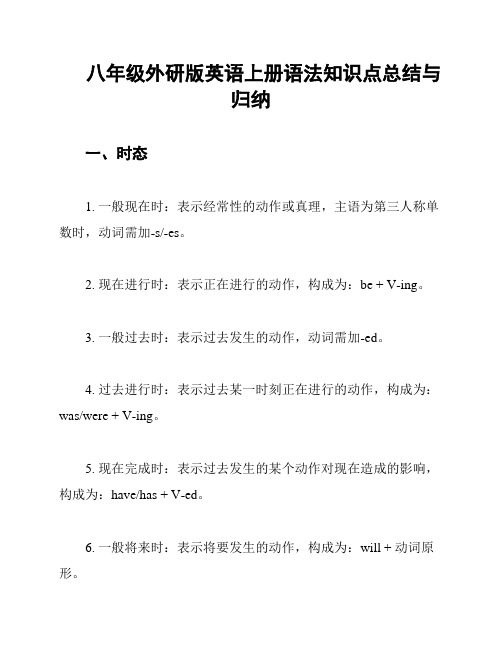
八年级外研版英语上册语法知识点总结与归纳一、时态1. 一般现在时:表示经常性的动作或真理,主语为第三人称单数时,动词需加-s/-es。
2. 现在进行时:表示正在进行的动作,构成为:be + V-ing。
3. 一般过去时:表示过去发生的动作,动词需加-ed。
4. 过去进行时:表示过去某一时刻正在进行的动作,构成为:was/were + V-ing。
5. 现在完成时:表示过去发生的某个动作对现在造成的影响,构成为:have/has + V-ed。
6. 一般将来时:表示将要发生的动作,构成为:will + 动词原形。
7. 现在完成进行时:表示过去开始进行的动作一直持续到现在,并可能持续下去。
构成为:have/has been + V-ing。
二、被动语态1. 被动语态的构成为“be + 过去分词”,被动语态的主语通常是动作的承受者。
2. 被动语态的时态和语态都可以通过助动词“be”加以表示。
三、情态动词1. 情态动词共有9个:can, could, may, might, must, shall, should, will, would。
2. 情态动词用于表示说话人的态度、感情或是某种推测,通常搭配动词原形使用。
四、关系代词1. who/whom:指人,作主语用who,作宾语或补语用whom。
2. whose:指人或物,表示所有关系。
3. that:指人或物,作主语、宾语、表语、定语等,引导限制性定语从句。
4. which:指物,作主语、宾语、表语、定语等,引导非限制性定语从句。
五、虚拟语气1. 虚拟语气用于表示现在或将来的假设情况或与过去相反的情况。
2. “if”引导的虚拟条件句中,主句通常要使用情态动词;与过去相反的虚拟语气要使用“were”。
六、倒装句1. 完全倒装:将助动词或情态动词提到主语前,用于表示强调或出乎意料的语气。
2. 部分倒装:将助动词、情态动词、系动词等提到主语前,用于表示疑问、否定、祝愿等语气。
最新外研版英语八年级上册知识点总结(精华版)
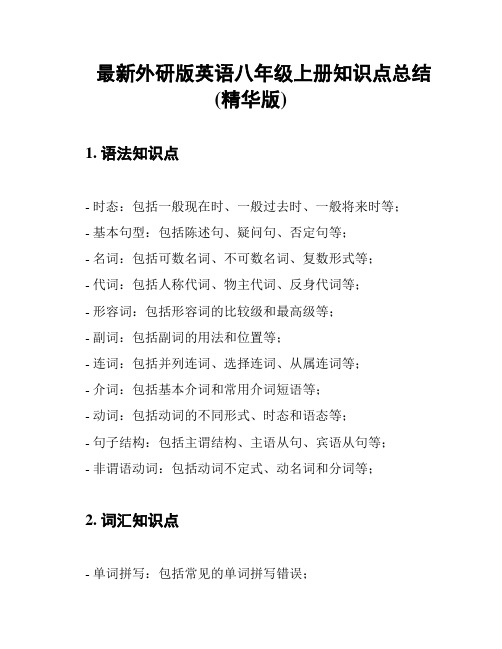
最新外研版英语八年级上册知识点总结
(精华版)
1. 语法知识点
- 时态:包括一般现在时、一般过去时、一般将来时等;
- 基本句型:包括陈述句、疑问句、否定句等;
- 名词:包括可数名词、不可数名词、复数形式等;
- 代词:包括人称代词、物主代词、反身代词等;
- 形容词:包括形容词的比较级和最高级等;
- 副词:包括副词的用法和位置等;
- 连词:包括并列连词、选择连词、从属连词等;
- 介词:包括基本介词和常用介词短语等;
- 动词:包括动词的不同形式、时态和语态等;
- 句子结构:包括主谓结构、主语从句、宾语从句等;
- 非谓语动词:包括动词不定式、动名词和分词等;
2. 词汇知识点
- 单词拼写:包括常见的单词拼写错误;
- 同义词:包括一些常见的同义词辨析;
- 常用短语:包括日常交际中常用的短语;
- 常用惯用语:包括一些惯用语的正确使用;
3. 阅读技巧
- 阅读理解:包括快速阅读和细节理解;
- 阅读速度:包括提高阅读速度和理解能力的方法;
- 阅读技巧:包括推测词义、寻找关键词等技巧;
4. 写作技巧
- 书信写作:包括格式、语言表达和常用句型等;
- 日记写作:包括表达个人感受和经历的方法;
- 作文写作:包括如何组织思路和提高写作水平的方法;
以上是最新外研版英语八年级上册的知识点总结,希望对你的研究有所帮助。
八年级外研版英语(上册)语法知识点汇总
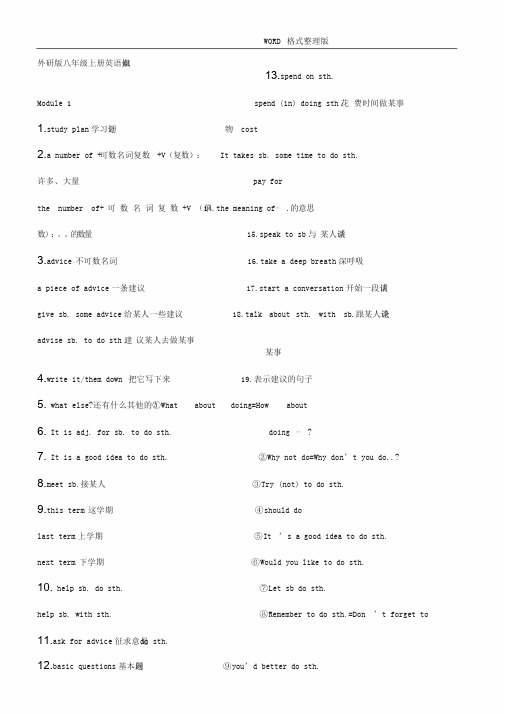
WORD 格式整理版识点外研版八年级上册英语知13.spend on sth..费时间做某事Module 1 spend (in) doing sth花1.study plan学习计划物cost2.a number of +可数名词复数+V(复数):It takes sb. some time to do sth.许多、大量pay for14.the meaning of⋯.的意思the number of+ 可数名词复数 +V (单话数):。
的数量15.speak to sb与.某人谈3.advice 不可数名词16.take a deep breath深呼吸话a piece of advice一条建议17.start a conversation开始一段谈give sb. some advice给某人一些建议18.talk about sth. with sb.跟某人谈论advise sb. to do sth建.议某人去做某事某事4.write it/them down 把它写下来19.表示建议的句子5. what else?还有什么其他的?①What about doing=How about6. It is adj. for sb. to do sth. doing ⋯?7. It is a good idea to do sth. ②Why not do=Why don’t you do..?8.meet sb.接某人③Try (not) to do sth.9.this term 这学期④should dolast term上学期⑤It ’s a good idea to do sth.next term 下学期⑥Would you like to do sth.10. help sb. do sth. ⑦Let sb do sth.help sb. with sth. ⑧Remember to do sth.=Don ’t forget to11.ask for advice征求意见d o sth.12.basic questions基本问题⑨you’d better do sth.学习好帮手***WORD 格式整理版l f其他知识点:14.lose one ’s way=lose one迷s e路15.be away from远离16. be sorry to do sth.17.listen to the radio听收音机18.write to sb.写给某人13.give up 放弃19.would like to do sth.愿意去做某事14. ask sb. to do sth让.某人去做某事20. want to do sth.15.improve oneself提高某人21. adj enough to do sth.rmation 消息信息,不可数名词22.try one’b s e s t to do sth.尽某人最大17.leave sth.落下什么东西能力去做某事18.in+一段时间(一般将来时)23. everyday (adj.) every day(adv.)19.not yet(还没有。
八年级外研版英语 上册 语法知识点汇总

八年级外研版英语上册语法知识点汇总的自我水平4.make progress取得进步5.set a goal设定目标6.work hard努力工作7.manage time管理时间8.ritize tasks优先安排任务9.review material复材料10.seek help寻求帮助11.stay motivated保持动力12.e obstacles克服障碍13.stay organized保持组织14.develop good habits养成好惯Study PlanHaving a study plan is important for students who want to make progress in their studies。
A good study plan should include a number of tasks that need to be completed within a specific timeframe。
The number of tasks should be manageable。
but enough to challenge the student。
It is also important to write down the plan and review it regularly to stay on track.When making a study plan。
it is a good idea to seek advice from teachers。
parents or other students。
They may have some basic ns that need to be addressed or can offer valuable advice on how to ritize tasks and manage time effectively。
外研八年级上知识总结

外研八年级上知识总结一、重要短语1. more and more 越来越多2. in the future 在未来3. do shopping 购物4. at the weekend 在周末5. get up 起床6. do homework 做作业7. go to bed 上床睡觉8. go to the cinema 去看电影9. on the/a weekend 在周末10. in a week 在一周内二、重点句型1. It will be + 形容词 + in + 时间段 + 表示未来某个时间点之前会发生的情况。
2. What will you do + 时间点?你将在什么时候做什么?3. How will you go to + 地点?你将如何去某地?4. Let’s + 动词原形 + 表示建议或提议。
5. What are you doing + 时间点?你正在做什么?6. When are you going + 动词不定式?你打算什么时候做某事?7. How long will it take you to do sth?做某事需要多长时间?8. It takes sb some time to do sth某人花费一些时间做某事。
9. I’m sorry to hear that听到这个消息我很难过。
10. I hope to do sth我希望做某事。
三、语法重点1. 将来时态的构成和用法。
2. 宾语从句的用法,包括连接词和语序。
3. 情态动词的用法,包括can、may、must等。
4. 现在完成时的用法,包括have/has been和have/has done的区别。
5. 形容词的比较级和最高级的用法。
6. 反身代词的用法,包括强调主语和表示强调等。
八年级外研版英语上册语法知识点汇总
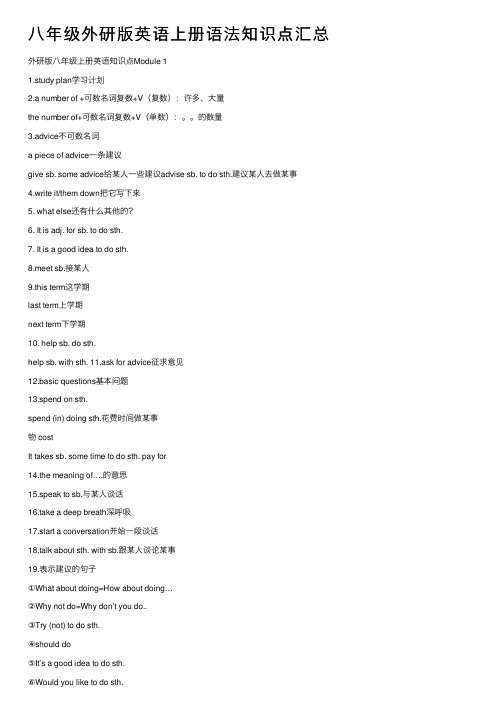
⼋年级外研版英语上册语法知识点汇总外研版⼋年级上册英语知识点Module 11.study plan学习计划2.a number of +可数名词复数+V(复数):许多、⼤量the number of+可数名词复数+V(单数):。
的数量3.advice不可数名词a piece of advice⼀条建议give sb. some advice给某⼈⼀些建议advise sb. to do sth.建议某⼈去做某事4.write it/them down把它写下来5. what else还有什么其他的?6. It is adj. for sb. to do sth.7. It is a good idea to do sth.8.meet sb.接某⼈9.this term这学期last term上学期next term下学期10. help sb. do sth.help sb. with sth. 11.ask for advice征求意见12.basic questions基本问题13.spend on sth.spend (in) doing sth.花费时间做某事物 costIt takes sb. some time to do sth. pay for14.the meaning of….的意思15.speak to sb.与某⼈谈话16.take a deep breath深呼吸17.start a conversation开始⼀段谈话18.talk about sth. with sb.跟某⼈谈论某事19.表⽰建议的句⼦①What about doing=How about doing…②Why not do=Why don’t you do..③Try (not) to do sth.④should do⑤It’s a good idea to do sth.⑥Would you like to do sth.⑦Let sb do sth.⑧Remember to do sth.=Don’t forget to do sth.⑨you’d better do sth.其他知识点:1.give up放弃2. ask sb. to do sth.让某⼈去做某事3.improve oneself提⾼某⼈/doc/dd7254801.htmlrmation消息信息,不可数名词5.leave sth.落下什么东西6.in+⼀段时间(⼀般将来时)7.not yet(还没有。
外研版八年级(上册)英语语法总结

一、 Module1:How to learn English一般现在时、一般过去时、一般将来时和现在进行时1.一般现在时( 1)定义:一般现在时表示经常或习惯性的动作或一般性事实。
( 2)用法:①表示事物或人物的特征、状态。
如:The sky is blue.天空是蓝色的。
②表经常反复性发生的动作。
如:I get up at six every day. 我每天六点起床。
③表示客观现实。
如: The earth goes around the sun.地球绕着太阳转。
④表示平日的喜好。
I like bananas. We don’t like vegetables.( 3)构成:① be 动词:主语 +be(am,is,are)+其它。
如:I am a boy.我是一个男孩。
②行为动词:主语 +行为动词 (+ 其它 ) 。
如:Westudy English.我们学习英语。
当主语为第三人称单数 (he, she,it等)时,动词词尾有所变化。
第三人称单数动词词尾的变化有几种形式:①一般情况加-s reads, says, takes②sh、ch、s、x、o 结尾的加 -es teaches, washes, goes, misses, mixes③以辅音字母加 y 结尾的词变y为i再加-es studies, cries, carries如: Mary likes Chinese.玛丽喜欢汉语。
Miss Gu teaches us English.顾老师教我们英语。
(4)句式变化:① be 动词的变化。
否定句:主句 +be+not+其它。
如:He is not a worker.他不是工人。
一般疑问:Be+主语 +其它。
如: -Are you a student?-Yes ,I am. / No,I’m not.特殊疑问句:特殊疑问词 +一般疑问句。
如: Where is my bike?② 行为动词的变化。
(外研版)初中英语八年级上册知识点归纳总结
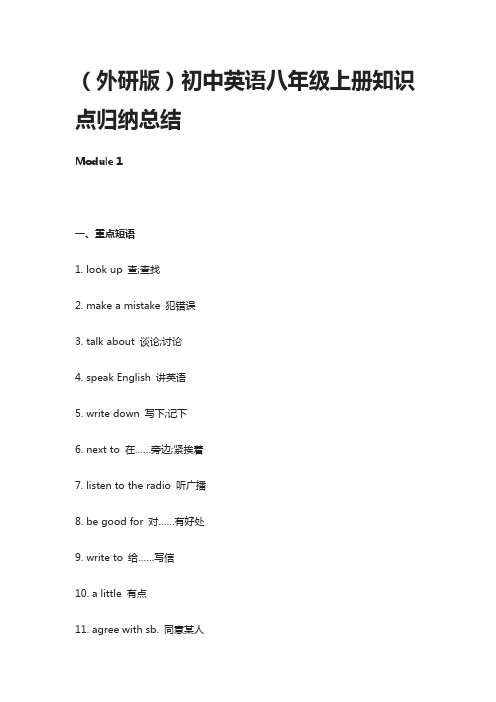
(外研版)初中英语八年级上册知识点归纳总结Module 1一、重点短语1. look up 查;查找2. make a mistake 犯错误3. talk about 谈论;讨论4. speak English 讲英语5. write down 写下;记下6. next to 在……旁边;紧挨着7. listen to the radio 听广播8. be good for 对……有好处9. write to 给……写信10. a little 有点11. agree with sb. 同意某人12. talk to 跟……交谈13. send sth. to sb. 把某物(发)送给某人14. ask for 请求15. watch films 看电影16. be from 来自17. smile at 冲……微笑18. go to bed 去睡觉19. get up 起床20. think about 考虑21. make friends with sb. 与某人交朋友22. take sb. around sp. 带领某人参观某地23. a few 几个;一些24. invite sb. to 邀请某人到……25. be good at 擅长26. for example 例如二、重点句型1. advise sb to do sth 建议某人做某事2. be afraid to... 害怕做……3. be good for... 对……有好处的4. be (a) great way(s) to do sth 做……的(一种)好方法5. It is natural to do sth. 做某事是合乎常情的。
三、重点语法1. Why not...? = Why don’t + you (we / they...)...?意为“为什么不……呢?”,后接动词原形。
eg:Why not / Why don’t we help the old cleantheir rooms this afternoon?今天下午为什么不去帮助老人打扫房间呢?2. What / How about...? 意为“……怎么样?”,其中about 是介词,后接名词或动词-ing 形式。
外研版八年级上册英语语法归纳总结

外研版八年级上册英语语法归纳总结3.形容词比较级的用法:(1)当两个人或事物(A和B)进行比较时,我们需要用到形容词的原级或者比较级①表达“A和B一样”,用as…as的结构。
公式: A+be动词+as+形容词原级+as…+Beg.: I am as tall as you.我和你一样高。
②表达“A不如B”用not as/so…as的结构。
公式:A+be动词的否定形式+as+形容词原级+as…+Beg.:I am not as tall as you.我没有你高。
③表达“A大于B”用“比较级+than”的结构。
公式:A+be动词+形容词比较级+than+B…e.g I am taller than you.我比你高。
(2)关于形容词比较级的更多用法6.副词原级的用法(1) 表示两者在某一方面程度相同时,用“as……as”结构,意为“和…一样地”。
公式:A + 实义动词 + as + 副词原形 + as + B例如:He swims as fast as I. 他和我游得一样快。
I play tennis as well as him (he dose).我网球打得和他一样好。
(2)表示两者在某一方面程度不相同时,用“not so(as)……as”结构,意为“不如,没有…”。
公式:A + 实义动词 + not+ as /so + 副词原形 + as + B例如:I can’t speak English so (as) fluently as you.我说英语不如你流利。
I can’t swim so fast as Jim.我无法游得像吉姆那么快。
*注意:在两者进行比较表示“A不如B”时,除使用“not...as/so+副词原级+as”结构外,还可以使用“less+副词原级+than”结构。
例如:He didn’t do his homework as carefully as his sister.=He did his homework less carefully than his sister.他做作业没有他妹妹认真。
外研版八年级上册重点语法复习总结

外研版八年级上册重点语法复习总结(总16页)--本页仅作为文档封面,使用时请直接删除即可----内页可以根据需求调整合适字体及大小--Module 1短语1. 查;查找look... up2. 尽可能……的 as... as possible3. ……的意思the meaning of...4. 听…… listen to5. 写下,记下write down6. 犯错误make a mistake7. 同意某人agree with sb8. 请求(给予)ask for9. 对某人微笑smile at sb10. 谈论talk about句型1. advise sb to do sth 建议某人做某事2. be afraid to... 害怕做……3. be good for... 对……有好处的4. be (a) great way(s) to do sth 做……的(一种)好方法5. It is natural to do sth. 做某事是合乎常情的。
语法运用——怎么“提建议”1. Why not... = Why don’t + you (we / they...)...意为“为什么不……呢”,后接动词原形。
例如:Why not / Why don’t we help the old cleantheir rooms this afternoon?今天下午为什么不去帮助老人打扫房间呢?2. What / How about... 意为“……怎么样”,其中 about 是介词,后接名词或动词 -ing 形式。
例如:What / How about drinking a cup of tea together?一起喝杯茶怎么样?What / How about a piece of cake?来块蛋糕怎么样?3. Let’s... 是一个以 Let’s 开头的祈使句,表示建议对方和自己一起做某事,意为“让我们(包括双方在内)……”,后接动词原形。
外研版八年级(上册)英语语法总结的复习要点
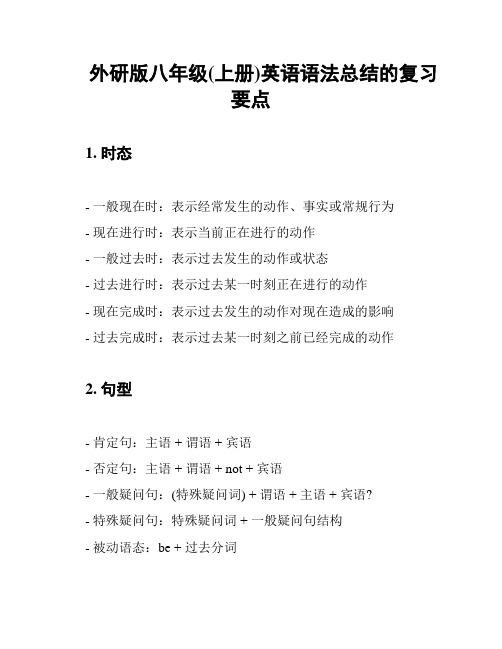
外研版八年级(上册)英语语法总结的复习
要点
1. 时态
- 一般现在时:表示经常发生的动作、事实或常规行为
- 现在进行时:表示当前正在进行的动作
- 一般过去时:表示过去发生的动作或状态
- 过去进行时:表示过去某一时刻正在进行的动作
- 现在完成时:表示过去发生的动作对现在造成的影响
- 过去完成时:表示过去某一时刻之前已经完成的动作
2. 句型
- 肯定句:主语 + 谓语 + 宾语
- 否定句:主语 + 谓语 + not + 宾语
- 一般疑问句:(特殊疑问词) + 谓语 + 主语 + 宾语?
- 特殊疑问句:特殊疑问词 + 一般疑问句结构
- 被动语态:be + 过去分词
3. 名词
- 可数名词:单数形式表示一个个体,复数形式表示多个个体- 不可数名词:表示一种整体或抽象概念,无复数形式
- 特殊名词:集体名词、物质名词等
4. 形容词和副词
- 形容词:修饰名词,通常放在名词前面
- 副词:修饰动词、形容词和其他副词
5. 介词
- 表示方位、时间、原因等关系
6. 从句
- 名词性从句:作主语、宾语、表语等
- 定语从句:修饰名词
- 状语从句:在主句中作状语
7. 情态动词
- 表示说话人的情感或态度,或表示能力、可能性等
8. 关系代词
- who, whom, which, that, whose等表示关系的词汇
以上为外研版八年级(上册)英语语法总结的复习要点,希望能帮助你顺利复习。
外研版八年级英语语法整理
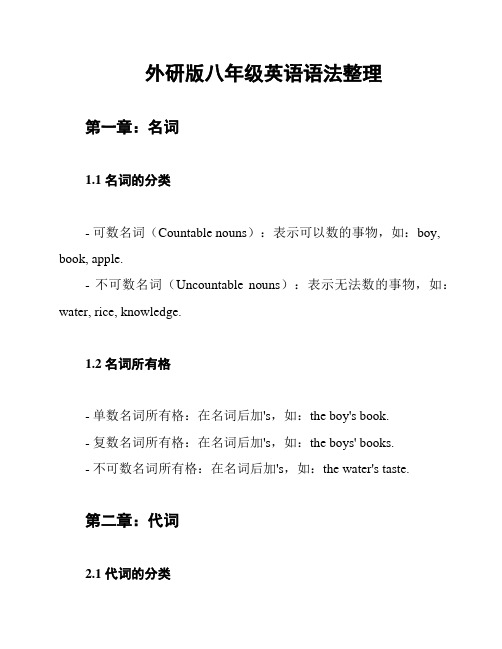
外研版八年级英语语法整理第一章:名词1.1 名词的分类- 可数名词(Countable nouns):表示可以数的事物,如:boy, book, apple.- 不可数名词(Uncountable nouns):表示无法数的事物,如:water, rice, knowledge.1.2 名词所有格- 单数名词所有格:在名词后加's,如:the boy's book.- 复数名词所有格:在名词后加's,如:the boys' books.- 不可数名词所有格:在名词后加's,如:the water's taste.第二章:代词2.1 代词的分类- 人称代词(Personal pronouns):I, you, he, she, it, we, they.- 物主代词(Possessive pronouns):mine, yours, his, hers, its, ours, theirs.- 反身代词(Reflexive pronouns):myself, yourself, himself, herself, itself, ourselves, yourselves, themselves.- 指示代词(Demonstrative pronouns):this, that, these, those.- 不定代词(Indefinite pronouns):some, any, every, each, many, much, few, little.2.2 代词的用法- 主格代词:用作主语,如:He likes apples.- 宾格代词:用作宾语,如:I saw him.- 形容词性物主代词:用于修饰名词,如:This is my book.- 副词性物主代词:用于表示所有关系,如:I put the book on the table.第三章:形容词和副词3.1 形容词的分类- 形容词分为:性质形容词(Qualitative adjectives)和程度形容词(Quantitative adjectives)。
外研版八年级英语上册语法知识点汇总
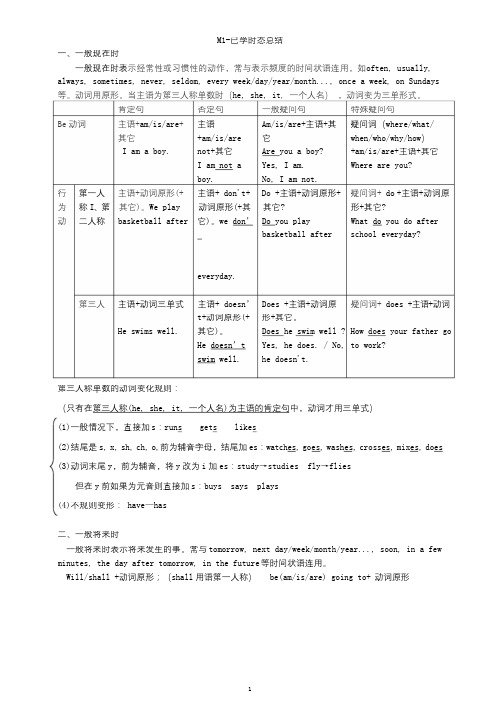
M1-已学时态总结一、一般现在时一般现在时表示经常性或习惯性的动作,常与表示频度的时间状语连用,如often, usually, always, sometimes, never, seldom, every week/day/year/month..., once a week, on Sundays 等。
动词用原形。
当主语为第三人称单数时(he, she, it , 一个人名) ,动词变为三单形式。
肯定句主语+am/is/are +主语 其它I am a boy. 否定句 一般疑问句 特殊疑问句 Be 动词 Am/is/are+主语+其 疑问词(where/what/ when/who/why/how ) +am/is/are 它 not+其它I am not aYes, I am. boy.No, I am not. 行 第一人 主语+动词原形(+主语+ don't+ Do +主语+动词原形+ 疑问词+ do +主语+动词原 Are you a boy? +am/is/are+主语+其它 Where are you? 为 称 I 、第 其它)。
We play 动词原形(+其 其它? 形+其它?动 二人称 basketball after 它)。
we don’ Do you playWhat do you do afterbasketball after school everyday? everyday.第三人 主语+动词三单式主语+ doesn’ Does +主语+动词原 疑问词+ does +主语+动词t+动词原形(+ 形+其它。
Does he swim well ? How does your father go He doesn’tYes, he does. / No, to work? swim well.he doesn't. He swims well. 其它)。
八年级上册外研版语法知识点总结
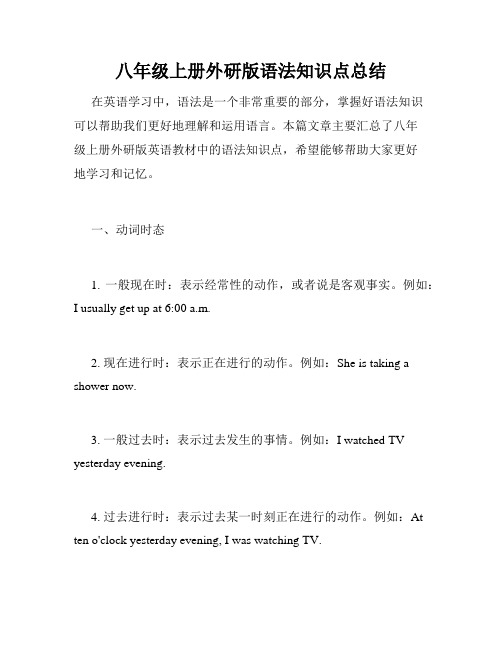
八年级上册外研版语法知识点总结在英语学习中,语法是一个非常重要的部分,掌握好语法知识可以帮助我们更好地理解和运用语言。
本篇文章主要汇总了八年级上册外研版英语教材中的语法知识点,希望能够帮助大家更好地学习和记忆。
一、动词时态1. 一般现在时:表示经常性的动作,或者说是客观事实。
例如:I usually get up at 6:00 a.m.2. 现在进行时:表示正在进行的动作。
例如:She is taking a shower now.3. 一般过去时:表示过去发生的事情。
例如:I watched TV yesterday evening.4. 过去进行时:表示过去某一时刻正在进行的动作。
例如:At ten o'clock yesterday evening, I was watching TV.5. 现在完成时:表示动作已经完成,与现在有关。
例如:Ihave finished my homework.6. 过去完成时:表示过去的某个时间点之前已经完成的动作。
例如:I had finished my homework before my mom came back.二、被动语态1. 一般被动语态:使用“be+V-ed”,表示主语是动作的接受者。
例如:The cake was made by my mom.2. 进行时被动语态:使用“be being+V-ed”,表示正在发生的被动动作。
例如:The table is being cleaned by a maid.3. 完成时被动语态:使用“have/has/had+been+V-ed”,表示动作已经完成的被动状态。
例如:The book had been read by me before.三、虚拟语气1. 虚拟语气用于表达非真实的情况,可以包括三种:①与现在事实相反:使用“were+主语”,例如:If I were you, I would buy this dress.②与过去事实相反:使用“had+V-ed”,例如:If I had known the answer, I would have told you.③表达目前可能或愿望:使用“should/would/could+V”,例如:If it should rain, we would stay at home.四、情态动词1. can/could:表示能力或者请求允许。
外研版八年级上册英语语法点汇总
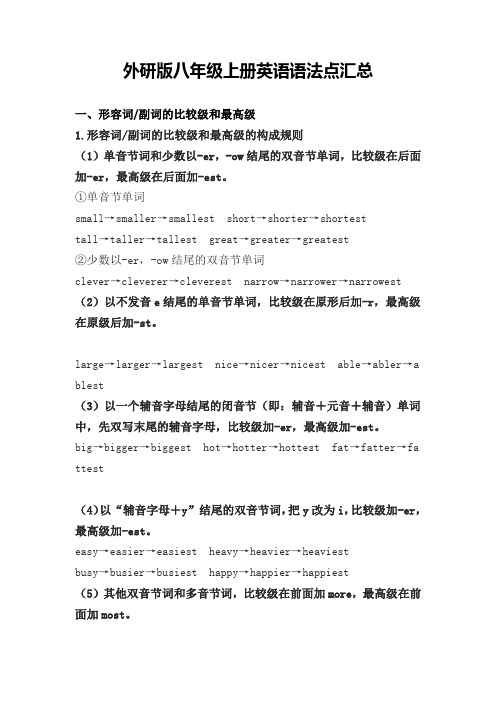
外研版八年级上册英语语法点汇总一、形容词/副词的比较级和最高级1.形容词/副词的比较级和最高级的构成规则(1)单音节词和少数以-er,-ow结尾的双音节单词,比较级在后面加-er,最高级在后面加-est。
①单音节单词small→smaller→smallest short→shorter→shortesttall→taller→tallest great→greater→greatest②少数以-er,-ow结尾的双音节单词clever→cleverer→cleverest narrow→narrower→narrowest (2)以不发音e结尾的单音节单词,比较级在原形后加-r,最高级在原级后加-st。
large→larger→largest nice→nicer→nicest able→abler→a blest(3)以一个辅音字母结尾的闭音节(即:辅音+元音+辅音)单词中,先双写末尾的辅音字母,比较级加-er,最高级加-est。
big→bigger→biggest hot→hotter→hottest fat→fatter→fa ttest(4)以“辅音字母+y”结尾的双音节词,把y改为i,比较级加-er,最高级加-est。
easy→easier→easiest heavy→heavier→heaviestbusy→busier→busiest happy→happier→happiest(5)其他双音节词和多音节词,比较级在前面加more,最高级在前面加most。
beautiful→more beautiful→most beautifuldifferent→more different→most differenteasily→more easily→most easily(6)有少数形容词、副词的比较级和最高级是不规则的,必须熟记。
good→better→best well→better→bestbad→worse→worst ill→worse→worstold→older/elder→oldest/eldestmany/much→more→most little→less→leastfar→further/farther→furthest/farthest2.形容词和副词比较级的用法(1)“甲+be+(倍数)+形容词比较级+than+乙”表示“甲比乙…”或“甲比乙…几倍”。
八年级上册英语重点语法外研版

八年级上册英语重点语法外研版第一节:一般现在时一般现在时是英语中最基本的时态之一,它表示习惯性的动作或者经常发生的动作。
在外研版八年级上册英语教材中,一般现在时的语法知识被重点介绍,学生需要掌握以下几点:1. 第三人称单数动词变化规则:在一般现在时中,第三人称单数形式的动词要在词尾加上-s。
例如:He goes to school by bus every day.2. 动作的频率副词:习惯性的动作或者经常发生的动作通常会使用频率副词来表达。
例如:I always do my homework after school.3. 一般现在时的疑问句和否定句:一般现在时的疑问句和否定句的构成也是学生需要掌握的重点之一。
例如:Does she like playing basketball? She doesn't like playing basketball.通过以上几点内容的学习,学生可以掌握一般现在时的基本用法,能够用简单的英语表达日常生活中的习惯和经常发生的动作。
第二节:比较级和最高级比较级和最高级是英语中用来表示事物在某一方面的大小、程度或者范围的重要语法知识点。
在外研版八年级上册英语教材中,比较级和最高级的用法被重点介绍,学生需要掌握以下几点:1. 比较级的构成规则:在比较级的构成中,一般情况下是在形容词或者副词前加上more或者-er。
例如:She is taller than her sister. The weather is getting colder.2. 最高级的构成规则:在最高级的构成中,一般情况下是在形容词或者副词前加上most或者-est。
例如:She is the tallest girl in the class. This is the most interesting book I have ever read.3. 比较级和最高级的用法:比较级用来进行两者之间的比较,而最高级则表示三者或者三者以上的比较。
- 1、下载文档前请自行甄别文档内容的完整性,平台不提供额外的编辑、内容补充、找答案等附加服务。
- 2、"仅部分预览"的文档,不可在线预览部分如存在完整性等问题,可反馈申请退款(可完整预览的文档不适用该条件!)。
- 3、如文档侵犯您的权益,请联系客服反馈,我们会尽快为您处理(人工客服工作时间:9:00-18:30)。
Modulel 1 .give you some advice 给你一些建议(advice 不可数名词)2 .讲…语(speak +语言)3. tell sb. about sth. 告诉某人关于某事4. talk to sb. 对某人谈话5. read+ 文字类物;look 与at 连用,have a look3. how (what )about doi ng sth 做什么怎么样4. ask (sb. )for sth. 请求某人获得6. have a message (短信,信息)for sb. 有某人的信息/ give sb. a message 给某人一条信息/ take a message for sb. 捎某人一个口信leave a message for sb. 给某人留个口信7. help sb with sth=help sb. to do sth. 在某方面帮某人8. translate sth. into sth. 把 ....... 翻译成...9. send sth to sb=send sb. sth. 把某物寄(送)给某人10. match sth. with sth. 把某物与某物搭配11. 不定代词,疑问副词(something, nothing, anything,everything,what )接else 表其他某物12. enjoy (doi ng )sth 享受(做)某事13. take a long time 花很长一段时间11. the mea ning ofsth. 某物的意思12 enjoy on eself =have a good time 过得开心13 lots of sth. =a lot of sth. 许多14 start a conv ersati on 开始谈话15 take a deep breath 深呼吸一下16 a piece of paper 一张纸18 best wishes 给予最好的祝愿19 the number of sth. 某物的数量(后接动词单数)20. a number of sth. 许多某物(后接动词复数)21. show / take sb arou nd 带某人参观22. write dow n sth. 写下23. make mistakes 犯八24. do some con certs 开音乐会25. on the In ternet 在网上26. a good idea 一个好主意27. a pen frie nd —个笔友28. school orchestra 学校管弦乐队29. in groups 分组30. each other 各自31. first of all= at first 首先32. what else 还有其他什么33. a piece of advice 一条建议借某物给34. borrow sth. from sb. 从某人借入某物lend sth. to sb.某人35. basic questio ns 基本的问题36. welcome back 欢迎回来37. in class 在课堂上38. next to 紧邻着 ..39」i ste n to sth. / sb. hear sth. / sb.40. everyday adj. 平常的,日常的every day 每天51. count the En glish words 数英语单词40 help sb. with sth. 帮助某人做某事二help sb. (to) do sth. 人做某事41make you shy 使你害羞make sb.+ adj. make sb. do sth.43 make a list 列个清单44. the best way to do sth. 做的最好方法45. make frie nds 结交朋友46th ink about sth./ doing sth. 考虑,think of sth. / doing sth.48 a new term 一个新学期49. in your notebook 在笔记本里帮助某想出51 read a newspaper 看报纸64. say hello to sb. 向某人问好/ 问候52. start a club 创建一个俱乐部53. what else 还有什么吗54. tha nk you for doing sth./sth. =tha nks for doing sth. / sth. 向你表感谢55. It takes +时间/金钱+to do sth.做某事花费多少时间或金钱56. practise (doing )sth. 练习(做)某事57. be good at (doing )sth. 擅长于(做)某事58. a piece of paper 一张纸,纸不可数59. always 放系动词后,实意动词之前二all the time 放句末(一直,总是)60. be good for (doi ng )sth. 对(做)某事有好处的61. It is + adj. (形容词)+ to do sth. 做某事是怎么样的62. look for sth.. 寻找某物63. show / take sb. arou nd 带领某人参观65. for example 例如smile at sb. 向某人笑hear from sb. = get a letter from sb. 收至U 某人的来信,hear of sb. / sth. 听说某人或某物hear about sb./ sth. 听说关于某人或某物建议句型:You should (not )do (原形)sth. 你应该(不)做2 Why don't you do (原形)sth.=Why not (原形)do sth. 你为什么不做…/为什么不做…3 How about doi ng sth. = What about doi ng sth. 做...怎么样4 It's a good idea to do (原形)sth. 做某事是一个好主意半功5 try to do (原形)sth. 试图做某事6 try not to do (原形)sht. 试图不做某事7. remember to do (原形)sth. 记得做某事8. D0n't forget to do (原形)sth. 不要忘记做某事9. It is a good way to do (原形)sth. 做某事是一个好方法/方式. Module2by pla ne 二take a pla ne fly to + 地方二take the pla ne to + 地方=go to + 地方by plane.2 on TV 在电视上3 in vite sb to do sth 邀请某人去做某事4 the price of sth. 某物的价格5 all over 遍及6take off 起飞land 着陆7 Spring Festival 春节8write about sth. 写关于.....9 western food 西餐10a fan tastic experie nee —次奇妙的经历11more tha n =over 超过13 give eon certs 开音乐会14 en ter ( =take part in ) a eompetiti on 参加竞赛15 sell out 卖光16 sound brilliant sound+ adj. 形容词听起来好极了17 taste delicious taste + adj. 形容词尝起来美味的18what kind of … 什么的种类.....19what's the price of …什么的价格......20have / has been to+ 地方去过某地(已回来)21a won derful experie nee —次极好的经历22have a won derful time 过得开心23eome true 实现24 in newspaper 在报纸里25 roast duck 烤鸭27 take photos 拍照28 the Great Wall 长城29 Beijing Opera 京剧30eook dinner 煮饭31 play the pia no 弹钢琴32.eabi n steward 客舱乘务员34 have / has gone to + 地方去了某地(还没回来)35. aga in and aga in —次又一次36. stay with sb. 与某人呆在一起also,too 也also 放于句中,too 放于句末38. anywhere 用于否定或疑问句哪些地方39. be / go abroad 在/ 去外国40. try to do sth. 尽力去做某事41. Chi nese musicia n 中国音乐家42. How many times …多少次 ....43. the first prize 第一份奖品44. look at sth. 看某物45. Italian food 意大利食品46. one of the boys 其中的男孩之一(后用动词单数)one of sth. 某屋之一47. the first prize 一等奖48. have / has been in+ 地方在某地住了(多久)49. It is + a / an + adj. + n. + to do sth. 做某事是怎么样的.at the end = fin ally 二at lastano the 叶名词单数(三者中)另一个…One ・・・the other… 一个…另-—一八个•…?do sth. better 更好地做某事现在完成时里副词用法:ever 为副词二at any time 在任何时候,曾经,常用于疑问句,否定句,比较状语从句以及条件状语从句;never 为副词, 绝不,从来没有,用于情态动词,助动词,be 动词之后或实义动词之前;以前before 用于陈述句和疑问句中,放在句末;yet 用于否定句,有时可用于一般疑问句,放于句末;already 已经一般用于肯定句中句型:Have / Has sb. ever done sth.Have / Has sb. done sth. yetSb. have / has done sth. yet.Sb. have / has already done sth.Sb. have / has bee n to + 地方Sb. have / has gone to + 地方Sb. have / has done sth. before.Sb. have / has n ever done sth.规则动词的过去分词变化与过去式一样,要求掌握的不规则动词现在完成时变化,参见课本199 和200 页.Module3 复习资料What are you up to = What are you doing 你正在做什么What do you recko n 你认为怎么样Do n't panic ! 别紧张!Make a model 做一个模型In space 在太空On the space stati on 在太空站上The latest news 最新的新闻solar system 太阳系space shuttle = spacecraft 太空飞船10. a small part of .......... 的一小部分11. so far 到目前为止12. speak to 对…说13. hear about 听说关于14. millions of 数以百万15. go around 围绕.... 转16. at night 在晚上17. finish doing … 完成做....18. as good as …与 .... 一样好19. write back 写回/ 回信20. send ・・・to…发送 ..21. in the uni verse 在宇宙22. in my life 在我的生命里23. none of sb. /sth. (没有)接谓语动词单数形式24.on earth 在地球上25. no one (没有人)接谓语动词单数形式26. so ・・・that太而.....28. several mon ths 几个月29. on bus in ess 出差30. discover life 发现生命31. bring ・back 带........ 回来34. an en vir onment with air 有空气的环境35. 200 billio n 两千亿36. beyond the solar system 远离太阳系discover sth. find sth.38. give us a break 别再烦我们了show sth. to sb. = show sb. sth.bring sb. sth.=bri ng sth. to sb.give sb. sth.=give sth. to sb.lend sb. sth. = lend sth. to sb.pass sb. sth.= pass sth. to sb.write sb. sth. =write sth. to sb.tell sb. sth.=tell sth. to sb.teach sb. sth. = teach sth. sb.buy sb. sth. = buy sth. for sb.show sb. aroundbring sb. sth. = bring sth. to sb. take sth. to sb.have / has gone to + 地方arrive at / in 二get to= reach(yet 用于现在完成时否定和疑问,放句末.already 用于现在完成时的肯定,放于句中.just ,by this time, ever ,never ,before, several times ,si nee ,up to now ,so far ,rece ntly ,lately ,for a long time )however 然而,放于句子开头there have / has bee n ; there will be=there is / are going to be;find / find out / look for sth. + cost+sb. + money sb. pay money for sth.。
